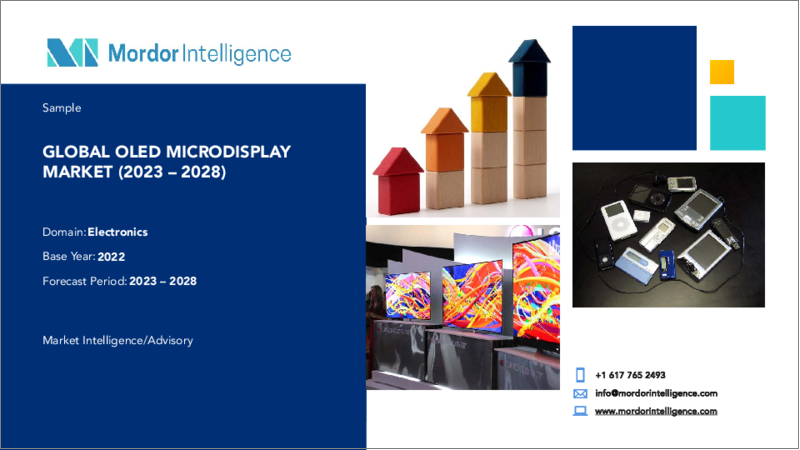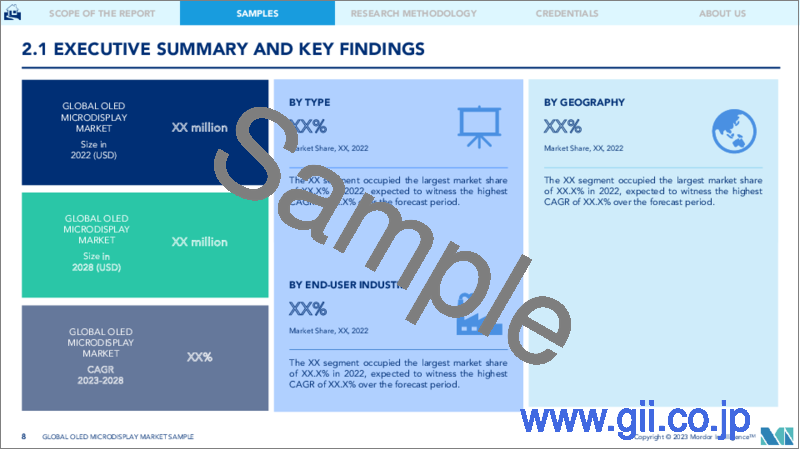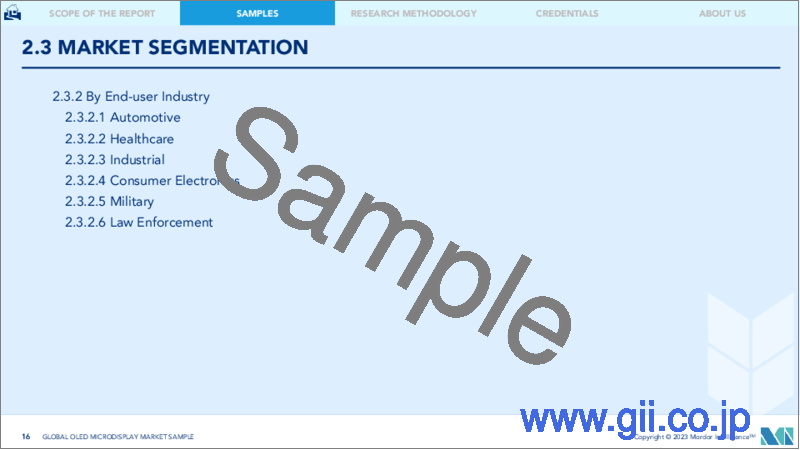|
|
市場調査レポート
商品コード
1197796
OLEDマイクロディスプレイ市場- 成長、動向、予測(2023年-2028年)OLED Microdisplay Market - Growth, Trends, and Forecasts (2023 - 2028) |
||||||
|
● お客様のご希望に応じて、既存データの加工や未掲載情報(例:国別セグメント)の追加などの対応が可能です。 詳細はお問い合わせください。 |
|||||||
| OLEDマイクロディスプレイ市場- 成長、動向、予測(2023年-2028年) |
|
出版日: 2023年01月23日
発行: Mordor Intelligence
ページ情報: 英文 120 Pages
納期: 2~3営業日
|
- 全表示
- 概要
- 目次
OLEDマイクロディスプレイ市場は、予測期間中に27.69%のCAGRで推移すると予想されています。
OLEDマイクロディスプレイは、コンパクトなサイズと高い画素密度が特徴です。スマートフォンやテレビなどの機器に搭載されることで、需要が拡大しています。また、OLEDマイクロディスプレイ市場は、参入障壁が低く、収益経路が拡大していることが大きな特徴となっています。
主なハイライト
- ディスプレイ産業は、様々な産業の様々なディスプレイニーズにより、実質的なブラウン管(CRT)から有機発光ダイオード(OLED)へと進化してきました。コンピュータのサイズは、メインフレームからパームトップへ、そして今や対角1インチ以下のディスプレイフレームへと進化しています。このようなフレームは、マイクロディスプレイ技術のニーズを生み出しています。
- パワー、コントラスト、サイズ、色空間などの利点から、NTEアプリケーションはOLEDマイクロディスプレイの最大のチャンスです。これは電子ビューファインダー(EVF)とパーソナルビューワ(PV)に関連します。現在、ニアアイOLEDマイクロディスプレイには3つの有力な市場があります。コンシューマー市場にはビデオ・VRメガネやEV、産業市場には物流用ARスマートグラス、防衛市場にはパイロット用ARヘルメットなどがあります。
- OLED技術は、市場で利用可能なLCOS、DLP、LCD技術よりも高解像度、低遅延、高コントラスト、高画質を提供します。OLEDマイクロディスプレイの需要は増加しています。例えば、4K VRヘッドセット、3D VR、ビデオゲーム用スマートグラスを提供する企業は、他の利用可能な技術よりもOLEDマイクロディスプレイを好んで使用しています。
- 有機ELを構成する金属陰極や有機材料の低仕事機能は、大気中の水分や酸素に非常に敏感です。水や酸素はプラスチック基板を透過し、成膜された電極を酸化させたり、機能性有機層を腐食させたりして、有機ELにダークスポットやエッジシュリンクを形成します。その結果、デバイスが劣化し、光出力が低下します。このような制約が、市場の成長を阻んでいます。
- COVID-19の大流行が世界のOLEDマイクロディスプレイ市場を大きく妨げています。COVID-19ウイルスの拡散を阻止するために多くの国でロックダウンが実施されたため、OLEDマイクロディスプレイシステムに使用される部品やコンポーネントの世界サプライチェーンが大きく中断されたのです。しかし、正常な状態に戻りつつあり、OLEDマイクロディスプレイの需要も急激に増加しており、市場の拡大を後押ししています。
OLEDマイクロディスプレイの市場動向
市場セグメンテーションでは、コンシューマーエレクトロニクス部門が大きなシェアを占める見通し
- 製品利用率の上昇により、世界の家電業界では市場の明るい見通しが生まれています。また、より良いゲーム体験を提供するために、OLEDマイクロディスプレイはデジタルカメラやスマートフォンを含む様々なデバイスと互換性のあるバーチャルリアリティヘッドセットに頻繁に使用されています。このように、より鮮明な画像と広い視野を持つディスプレイを搭載した小型の電子機器に対する消費者の嗜好の変化が、市場の成長を後押ししています。
- さらに、高い光学性能と優れたコントラスト比を持つ超高精細・高解像度(UHD/HD)OLEDマイクロディスプレイの発売など、多くの技術的進歩が市場成長を後押ししています。
- また、マイクロディスプレイ市場は、デジタルカメラの革新と開拓の恩恵を受けています。OLEDマイクロディスプレイは、より鮮明な画像、広い視野角、制限を克服する能力を備えたディスプレイに対する消費者の需要により、市場シェアを獲得しました。消費者の可処分所得の増加により、最先端かつ高級な商品への需要が高まっています。これらの製品は現在、エンターテインメントを媒体としており、新しいディスプレイ技術の採用が反映されています。デジタルカメラやバーチャルリアリティなどの民生用電子機器の普及が進んでいます。
- VRヘッドセットなど、家電製品の利用が拡大しています。より良いゲーム体験のために、子供たちはスマートフォンやその他のガジェットとの互換性がより高いVRヘッドセットを使用しています。新型スマートフォンのほか、サムスンやHTCなどのメーカーもVRヘッドセットを販売しています。
- 予測期間中、VRゲーム用ヘッドセットの人気上昇と、より小型で携帯性の高い電子機器への消費者嗜好のシフトにより、市場は有利に成長すると予測されます。
- さらに、今後数年間は5Gスマートフォンの割合が増加することが予想されます。ディスプレイ技術の発展に伴い、有機ELの折りたたみ式携帯電話の普及率が高まると思われます。スマートフォンの普及率は、スマートフォンブランドがスペックの向上と手頃な価格設定により、新しいフラッグシップの折りたたみ型端末を定期的に発売することで上昇すると思われます。エリクソン社によると、今年、世界のスマートフォン契約数は60億を突破しました。今後数年間で、さらに数億台の成長が見込まれています。
アジア太平洋地域が最速の成長市場となる見込み
- アジア太平洋地域は、都市化の進展とディスプレイの技術的進歩により、市場調査対象となった著名な地域の一つです。アジア太平洋地域には大手企業が存在し、先進技術の採用が進み、設備投資が増加し、経済が急速に成長しているため、OLEDマイクロディスプレイには大きな可能性があります。
- アジア太平洋地域のOLEDマイクロディスプレイ市場では、中国が主要な供給先として浮上しています。大規模な顧客基盤に加え、投資家に優しい規制があるため、新規参入するプレイヤーを惹きつけています。また、高度な家電製品や革新的なディスプレイ技術に対する需要の高まりは、調査対象市場の成長にとって有利な市場シナリオを生み出しています。
- さらに、OLEDディスプレイの需要増は、新規および既存のベンダーが新しい製造設備への投資を増やすために市場に参入することも後押ししています。例えば、今年6月、OLEDマイクロディスプレイ開発大手であるBCDTEKは、中国淮南に12インチOLEDマイクロディスプレイ生産拠点を建設すると発表しました。同社によると、月産2万枚の基板生産能力を持つことになります。
- HMDやHUDの需要の増加は、日本もHMDやHUDの主要サプライヤーを構成しているため、日本市場を促進すると予想されます。日本では、自動車、民生、産業、企業などがマイクロディスプレイベースのデバイスが使用される主要産業です。日本の主要マイクロディスプレイメーカーは、セイコーエプソン、ソニー、シチズンファインデバイスなどです。
- 中国、日本、韓国などの国以外にも、台湾やインドなどの国々の電子産業が成長していることも市場の成長に寄与しています。さらに、これらの国々の中産階級の可処分所得が増加していることも、調査された市場に新しい機会をもたらしています。
OLEDマイクロディスプレイ市場の競争者分析
OLEDマイクロディスプレイ市場は、Microoled SA(Photonis Technologies SAS), Yunnan Olightek Opto-electronic Technology, Winstar Display, Emagin Inc, and Kopin Corp.などの大手企業が存在し、非常に断片化されています。市場のプレーヤーは、製品提供を強化し、持続的な競争優位性を獲得するために、パートナーシップや買収などの戦略を採用しています。
2022年8月、ソニーが供給するMicro OLEDがXiaomiの新しいカメラとデータメガネ「Mijia」に採用されました。ソニーが供給したディスプレイは、最大輝度3,000nits、解像度3,281PPIを実現しています。MijiaGlassesのカメラは、Snapdragon 8チップセットと光学5倍ズームのデュアルカメラを搭載したAR HMDデバイスです。
その他の特典。
- エクセル形式の市場予測(ME)シート
- アナリストによる3ヶ月間のサポート
目次
第1章 イントロダクション
- 調査の前提条件と市場の定義
- 調査対象範囲
第2章 調査手法
第3章 エグゼクティブサマリー
第4章 市場力学
- 市場概要
- 産業の魅力度-ポーターファイブフォース
- 供給企業の交渉力
- 買い手の交渉力
- 新規参入業者の脅威
- 代替品の脅威
- 競争企業間の敵対関係
- 産業バリューチェーン分析
- COVID-19がOLEDマイクロディスプレイ市場に与える影響
第5章 市場力学
- 市場促進要因
- NTE(Near-to-eye)アプリケーションの増加
- 高解像度、高画質、低消費電力
- 市場の課題
- 酸素と水蒸気に対するOLED層の保護
- 高温下での輝度・寿命の確保
第6章 市場セグメンテーション
- タイプ
- 近視眼用
- プロジェクション
- エンドユーザー産業
- 自動車
- ヘルスケア
- 産業機器
- 民生用電子機器
- 軍事
- 法執行機関
- 地域別
- 北米
- 欧州
- アジア太平洋地域
- 世界のその他の地域
第7章 競合情勢
- 企業プロファイル
- Microoled SA(Photonis Technologies SAS)
- Yunnan Olightek Opto-electronic Technology Co. Ltd
- Winstar Display Co. Ltd
- Emagin Inc.
- Kopin Corp.
- Wisechip Semiconductor Inc.
- Seiko Epson Corp.
- Fraunhofer FEP
- Sony Semiconductor Solutions Corp.
- Sunlike Display Technology Corp.
第8章 投資分析
第9章 市場の将来性
The OLED microdisplay market is expected to register a CAGR of 27.69% during the forecast period. OLED microdisplays offer a compact size with high pixel density. The market is witnessing growth in demand owing to the increased use of microdisplays in devices such as smartphones, television, etc. Moreover, low entry barriers and growing avenues of revenue are the prominent attributes in the OLED microdisplay market.
Key Highlights
- The display industry has advanced from the substantial cathode ray tube (CRT) to the organic light-emitting diode (OLED), owing to the different display needs of various industries. Advancements in computer sizes range from mainframes to palmtops, and now to a display frame that is less than an inch, diagonally. These frames are generating the need for microdisplay technologies.
- Due to power, contrast, size, and color-space advantages, NTE applications represent the largest opportunity for OLED microdisplays. This relates to electronic viewfinders (EVF) and personal viewers (PV). Currently, there are three prominent markets for near-eye OLED micro-displays. The consumer market encompasses video and VR glasses and EV, industrial covers AR smart glasses for logistics, defense market targets AR helmets for pilots.
- OLED technology offers high resolution, low latency, higher contrast, and picture quality than LCOS, DLP, and LCD technologies available in the market. The demand for OLED microdisplays is increasing. For example, companies offering 4K VR headsets, 3D VR, and smart glasses for video games, prefer OLED microdisplays over other available technologies.
- The low-work function of metallic cathodes and organic materials consisting of OLEDs is highly sensitive to atmospheric moisture and oxygen. Water and oxygen penetrate through plastic substrates to form dark spots and edge shrinkages in OLEDs by oxidizing the as-deposited electrodes or corroding the functional organic layers. This results in device degradation and reduced light output. Such limitations are challenging the market growth.
- The COVID-19 pandemic has significantly hampered the global OLED microdisplay market. The global supply chain for the parts and components used in OLED microdisplay systems has been severely disrupted due to the lockdown imposed in a number of nations to stop the COVID-19 virus' spread. However, as the situation is returning to normal, there is an exponential rise in demand for OLED microdisplays, which propels market expansion.
OLED Microdisplay Market Trends
Consumer Electronics Segment is Expected to Hold Significant Market Share
- The rising product utilization is creating a positive outlook for the market in the consumer electronics industry worldwide. Also, to provide a better gaming experience, OLED microdisplays are frequently used in digital cameras and virtual reality headsets that are compatible with various devices, including smartphones. Accordingly, the market growth is aided by consumers' shifting preferences for smaller electronic devices with displays with clearer images and a wide field of view.
- Additionally, many technological advancements, including the release of ultra-high-definition and high-definition (UHD/HD) OLED microdisplays that offer high optical performance and excellent contrast ratio, are boosting the market growth.
- Also, the microdisplay market has benefited from the innovation and development of digital cameras. The OLED microdisplay has gained market share thanks to consumer demand for a display with a clearer image, a wide viewing angle, and the ability to overcome limitations. Consumers' rising disposable income increased the demand for cutting-edge and upscale goods. These products now use entertainment as a medium, which reflects the adoption of new display technologies. Digital cameras and other consumer electronics, such as virtual reality, are becoming more widely used.
- The use of consumer electronics is expanding, including VR headsets. For a better gaming experience, kids use VR headsets that are more frequently compatible with smartphones and other gadgets. Besides new smartphones, manufacturers like Samsung and HTC also sell VR headsets.
- During the forecast period, the market is predicted to grow favorably due to the rising popularity of VR gaming headsets and a shift in consumer preferences toward smaller, more portable electronic devices.
- Additionally, the percentage of 5G smartphones is expected to increase in the upcoming years. The penetration rate of OLED folding mobile phones will grow as display technology develops. The smartphone penetration rate would increase as smartphone brands launch new flagship folding devices regularly, driven by improved specifications and more affordable pricing. According to Ericsson, the number of smartphone subscriptions globally surpasses six billion in the current year. It is forecast to grow further by several hundred million in the next few years.
Asia Pacific is Expected to be the Fastest Growing Market
- The Asia-Pacific is one of the prominent regions for the market studied due to the rising urbanization and technological advancements in display screens. There is a massive potential for OLED microdisplays in Asia-Pacific due to the presence of major players across the region, increasing adoption of advanced technology, increasing capital investments, and rapidly growing economies.
- China has emerged as the leading destination in the Asia-Pacific's micro-OLED display market. The large customer base, along with investor-friendly regulations, is attracting new players to enter the market. The increasing demand for advanced consumer electronic products and innovative display technologies are also creating a favorable market scenario for the growth of the market studied.
- Furthermore, the increasing demand for OLED displays is also encouraging new and existing vendors to enter the market to increase their investment in new manufacturing facilities. For instance, in June this year, BCDTEK, a leading OLED microdisplay developer, announced that it would construct a 12-inch OLED microdisplay production site in Huainan, China, according to the company, would have a production capacity of 20,000 monthly substrates.
- The increasing demand for HMDs and HUDs is expected to propel the market in Japan as Japan also comprises major suppliers of HMDs and HUDs. Automotive, consumer, industrial, and enterprise are key industries in Japan in which microdisplay-based devices are used. Major microdisplay providers in Japan include Seiko Epson, Sony, and Citizen Finedevice.
- Apart from the countries like China, Japan, and South Korea, the growth of the electronics sector across countries such as Taiwan and India is also favoring the market's growth. Furthermore, the increasing disposable income among the middle-class population across these countries is also creating new opportunities for the market studied.
OLED Microdisplay Market Competitor Analysis
The OLED microdisplay market is highly fragmented with the presence of major players like Microoled SA (Photonis Technologies SAS), Yunnan Olightek Opto-electronic Technology Co. Ltd, Winstar Display Co. Ltd, Emagin Inc., and Kopin Corp. Players in the market are adopting strategies such as partnerships and acquisitions to enhance their product offerings and gain sustainable competitive advantage.
In August 2022, Micro OLEDs supplied by Sony were used in Xiaomi's new camera and data glasses, "Mijia". The display supplied by Sony offers a maximum brightness of 3,000 nits and a resolution of 3,281 PPI. MijiaGlasses camera is an AR HMD device with a Snapdragon 8 chipset and dual cameras with 5X optical zoom.
Additional Benefits:
- The market estimate (ME) sheet in Excel format
- 3 months of analyst support
TABLE OF CONTENTS
1 INTRODUCTION
- 1.1 Study Assumptions and Market Definition
- 1.2 Scope of the Study
2 RESEARCH METHODOLOGY
3 EXECUTIVE SUMMARY
4 MARKET DYNAMICS
- 4.1 Market Overview
- 4.2 Industry Attractiveness - Porter Five Forces
- 4.2.1 Bargaining Power of Suppliers
- 4.2.2 Bargaining Power of Buyers
- 4.2.3 Threat of New Entrants
- 4.2.4 Threat of Substitutes
- 4.2.5 Intensity of Competitive Rivalry
- 4.3 Industry Value Chain Analysis
- 4.4 Impact of Covid-19 on the OLED Microdisplay Market
5 MARKET DYNAMICS
- 5.1 Market Drivers
- 5.1.1 Increasing Number of Near-to-eye (NTE) Applications
- 5.1.2 High Resolution, Excellent Picture Quality, and Low Power Consumption
- 5.2 Market Challenges
- 5.2.1 Protection of OLED Layers against Oxygen and Water Vapor
- 5.2.2 Luminance and Lifetime Specifically under High-temperature Conditions
6 MARKET SEGMENTATION
- 6.1 Type
- 6.1.1 Near-to-eye
- 6.1.2 Projections
- 6.2 End-User Industry
- 6.2.1 Automotive
- 6.2.2 Healthcare
- 6.2.3 Industrial
- 6.2.4 Consumer Electronics
- 6.2.5 Military
- 6.2.6 Law Enforcement
- 6.3 Geography
- 6.3.1 North America
- 6.3.2 Europe
- 6.3.3 Asia-Pacific
- 6.3.4 Rest of the World
7 COMPETITIVE LANDSCAPE
- 7.1 Company Profiles
- 7.1.1 Microoled SA (Photonis Technologies SAS)
- 7.1.2 Yunnan Olightek Opto-electronic Technology Co. Ltd
- 7.1.3 Winstar Display Co. Ltd
- 7.1.4 Emagin Inc.
- 7.1.5 Kopin Corp.
- 7.1.6 Wisechip Semiconductor Inc.
- 7.1.7 Seiko Epson Corp.
- 7.1.8 Fraunhofer FEP
- 7.1.9 Sony Semiconductor Solutions Corp.
- 7.1.10 Sunlike Display Technology Corp.




